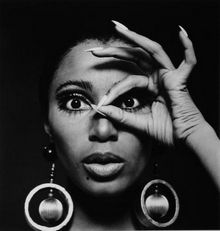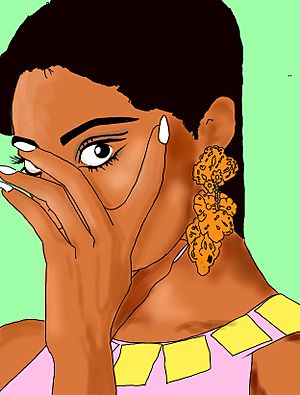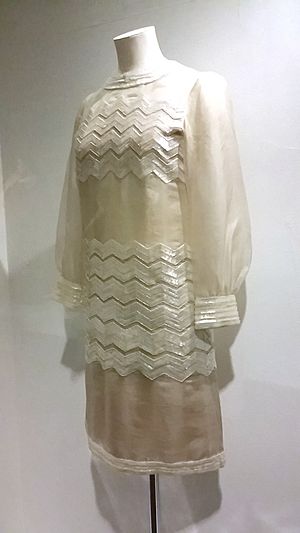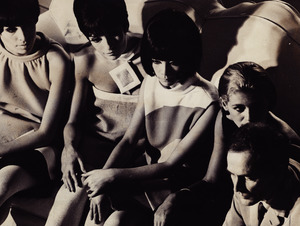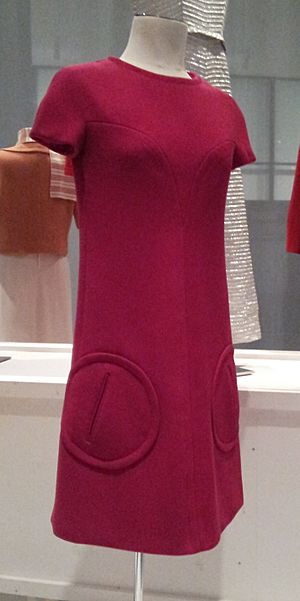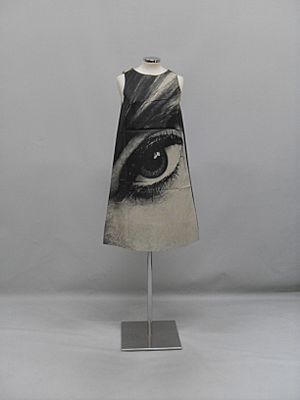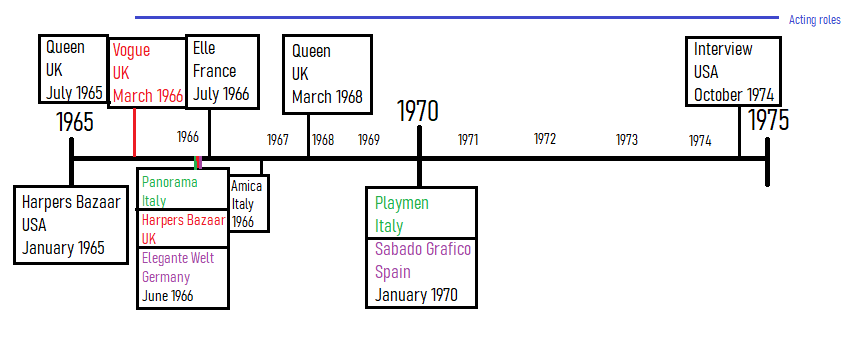Donyale Luna facts for kids
Peggy Ann Freeman (born August 31, 1945 – died May 17, 1979) was a famous American supermodel and actress. She was known professionally as Donyale Luna. She became very popular in Europe during the exciting late 1960s.
Many people call Donyale Luna "the first Black supermodel." She was the first African-American model to be on the cover of the British Vogue magazine. This happened in March 1966. Before her, other Black models like Adrienne Fidelin and Anthea August had worked in fashion. But Luna was seen as a pioneer who helped change beauty standards. She appeared on 11 magazine covers between 1965 and 1975.
Donyale Luna also acted in several underground films. She worked with famous artists like Andy Warhol. She had roles in movies such as Qui êtes-vous, Polly Maggoo? (1966) and Skidoo (1968). Her most famous film role was Enotea in the 1969 movie Fellini Satyricon by Federico Fellini.
Contents
Growing Up in Detroit
Donyale Luna was born Peggy Ann Freeman in Detroit, Michigan, in 1945. Her parents, Nathaniel and Peggy Freeman, were working-class people. They had moved to Detroit from Georgia as part of the Great Migration. Her father worked at the Ford car plant. Her mother was a secretary for the Young Women's Christian Association.
Peggy Ann was one of three daughters. Her family lived in a stable middle-class neighborhood. As a child, she often went to the movies with her father. In the summer, she swam at the "Kronk Gym" in Detroit.
She first went to Detroit High School of Commerce. There, she studied data processing and typing. Later, as a teenager, she attended Cass Technical High School. She studied journalism, performing arts, and languages. She was also in the school choir and local theater groups.
Around age 18, she started calling herself "Donyale George Luna." This new name might have helped her deal with family changes. She also began speaking with a unique accent she invented. Her mother said it sounded "like she was singing." Luna wanted to be an actress. Her sister described her as "a very weird child, even from birth, living in a wonderland, a dream." She often made up stories about her background.
She took on roles in plays like Paint Your Wagon and The Tempest. After rehearsals, she would go to coffeehouses with her boyfriend. She dressed in all black, inspired by the Beatniks. People noticed her unique style. One director called her a "kook" because she often walked around barefoot.
Luna later said that in Detroit, she wasn't seen as beautiful. A fellow student remembered her as "striking." But Luna felt like an "oddball" because she talked and looked different. She said, "I grew up realizing I was strange."
In October 1964, she moved to New York to become an actress and model. She worked as a secretary for a while. She eventually got her own apartment and joined an actor's union. Her sister said she packed very little, as if going on a short trip.
For the next five years, Luna traveled between Europe and North America. By 1972, she had moved to Rome. She continued modeling for top designers like Ted Lapidus. She could earn a lot of money for a single day of work.
Modeling Career Highlights
Starting in Detroit and New York
The English photographer David McCabe discovered Donyale Luna in Detroit in 1963. He invited her to New York City to become a model. At first, her mother wanted her to be a nurse. But Luna was determined. Her mother eventually sent her to live with an aunt in New Jersey.
In October 1964, Luna contacted McCabe. He shared her photos with different agencies. McCabe introduced her to Harper's Bazaar editor Nancy White and photographer Richard Avedon. Nancy White signed Luna to a special contract. Avedon became her manager. Her first modeling job was for Mademoiselle magazine, featuring Woody Allen.

In 1964, Luna modeled for designer Paco Rabanne. She saw American journalists react negatively to Rabanne's fashion show. They were upset because he used only Black models.
In January 1965, Luna became the first Black person on the cover of Harper's Bazaar. Her image was drawn as an illustration. It was shown in a way that made her ethnicity unclear. This was her first work for the magazine.
In April 1965, Avedon photographed her again for Harper's Bazaar. She appeared with famous people like Paul McCartney and Jean Shrimpton. The magazine described her using language that compared her to a "Masai Warrior." This language was seen as prejudiced. Around this time, Luna also started having problems with Avedon. She felt he became too controlling as she became more successful.
Luna's career faced challenges in the U.S. because of racial prejudice. Southern advertisers complained about her images in Harper's Bazaar. Some even pulled their ads. Designers like Mainbocher and Norman Norell refused to let Luna wear their clothes. After her contract ended, the magazine's owner stopped Avedon from working with her. Many believed this was due to racism in the fashion business.
Black models were often shown in an "exotic" way. They were expected to look like outsiders from "primitive African cultures." One writer noted that Luna's breakthrough meant Black models could have a career. But her unique style was not easy for other women to copy.
In 1966, American Vogue named Donyale Luna "The Model of the Year." Jet magazine called her "the most photographed girl of 1966." She was seen as a top model in Europe.
By 1966, Luna was an internationally recognized model. She appeared in Cosmopolitan in November 1966. She also appeared in American Vogue in August 1969. In 1970, she was in an ad for colored contact lenses. She often wore them to change her eye color.
Moving to London
Luna arrived in London in December 1965. This city became where she truly made her name. London was experiencing the "Swinging London" cultural revolution. This included Beatlemania and new fashions like Mary Quant's miniskirts. Luna was photographed by famous photographers like David Bailey and Helmut Newton. She became friends with celebrities like Mick Jagger and Julie Christie.
She made history as the first African-American model on the cover of any Vogue magazine. This was the March 1966 British issue, photographed by David Bailey. Bailey described her as "extraordinary-looking, so tall and skinny." He said she was "like an illustration." He didn't care about her race, only her unique look. The Vogue staff liked using a Black model. But the sales team often had problems with it.
The cover photo was inspired by surrealist artist Pablo Picasso. One of Luna's eyes peered from between her fingers. She wore a Chloé dress and Mimi de N earrings. Inside the magazine, she wore designs by Christian Dior and Pierre Cardin.
Some people online have suggested the photo hid her race. But her family said in 2019 that the shot was chosen for its artistic style. It showed her eye through her fingers, forming a "V" for Vogue.
She was also photographed for the German magazine Twen in March 1966. Fellow model Pat Cleveland said Luna had amazing presence. People would stop and applaud when she walked into restaurants. Time magazine called her "a new heavenly body" in 1966. They said she was "a Negro, hails from Detroit, and is not to be missed."
In April 1966, she appeared again in Vogue UK. She was featured in a story about "This Summer's dancing patterns." In June 1966, she was on the cover of Harper's Bazaar UK. Her features and skin color were not edited out in this photo. In October 1966, she was in a Vogue shoot with Audrey Hepburn.
In 1967, a famous mannequin designer, Adel Rootstein, created a model based on Luna. This mannequin had Luna's tall figure. Jet magazine described it as "unmistakably Negro, excellently sculpted." Luna was paid well to pose for this work.
On March 27, 1968, she was on the cover of the British magazine Queen. She wore a headwrap. In November 1968, Luna and her friends were asked to leave a London hotel restaurant. The hotel said the men were not dressed properly. Luna asked if it was because she was Black. They were all denied service and police were called. Luna later told the American press it was a "nightmare" and due to her being "colored."
By 1969, she was earning "$1,000 a week" for her modeling work.
Modeling in Paris
Donyale Luna was originally supposed to be on the cover of Vogue Paris before British Vogue. The French editor, Edmonde Charles-Roux, had photographed Luna for the cover. But the cover was changed at the last minute to show two white models. This was done to avoid offending readers by featuring a Black model. Charles-Roux was later fired for trying to put a Black model on the cover. It took another 22 years for Naomi Campbell to be on the cover of Vogue Paris.
By 1966, Luna was confident in her career. She said, "Being what I am, I can get what I ask." She modeled for Paco Rabanne in his first Paris show, "12 Unwearable Dresses." She also worked for Paris Match magazine. She was photographed in unusual places, like on a helicopter's landing gear and underwater. She also modeled for designers like Guy Laroche and Emanuel Ungaro.
She appeared on the cover of Elle in July 1966. She was photographed by Ronald Traeger in a long toga dress.
Modeling in Sydney
In 1967, Luna modeled in Sydney, Australia. She wore paper dresses for a store called Paraphernalia. These dresses were a popular trend among teenagers at the time. She also walked in a fashion show called the "Donyale Luna spectacular."
Modeling in Italy
Luna appeared in the Italian magazine Amica in 1966. She wore animal print and fur coats. She was also photographed for Vogue Italia. In 1968, she modeled for camera advertisements. She bought an apartment in Italy in 1970. She drove a small Cinquenta car to her modeling shoots.
In January 1970, she appeared in the Italian adult magazine Playmen. She wore fishnet outfits in a multi-page spread. She was reportedly asked to leave Italy by police for not having the right paperwork. But her husband later said she was harassed in Rome because of her skin color.
When Luna moved to Italy in 1974, she worked with her husband on photo shoots. She also created art like illustrated fairy tales and film scripts. She was very creative during this time. However, she also felt a deep sense of loneliness.
She wrote a piece called LUNAFLYLABY. In it, she talked about her childhood and her experiences in the fashion world. She also wrote about being a biracial woman. She felt that society sometimes made Black women "invisible." She also modeled for artist Peter Beard in 1977.
Returning to North America
Luna returned to the U.S. and Canada for about a year between 1973 and 1975. She did runway modeling in New York, California, and Toronto. She appeared on the cover of Andy Warhol's Interview magazine in October 1974.
However, Luna's modeling career began to slow down. This was partly because she wanted to focus more on acting. Also, some media outlets criticized her unusual behavior. Model Beverly Johnson once said Luna was eccentric. But Johnson later recognized Luna's importance. In 2016, she said Luna "made it possible for models like me." She called Luna "one of those legends in our industry."
In June 1975, Luna attended a fashion show in New York. She was seen "posing in a veiled harem outfit."
Luna's Unique Walk
Donyale Luna had a regular catwalk walk. It was described as a "free-form, hip-popping strut." But she was also known for her very unusual walking styles. These styles are still used by some models today. Luna was eccentric since she was a child. This came from her acting experience in experimental theater. She was drawn to avant-garde artists like Salvador Dalí and Andy Warhol. She brought these influences to her modeling.
She developed a style called "method modeling." This was based on method acting. She would crawl like a lion, groove to the music, or freeze and stare at journalists. She might walk like a robot or crawl on all fours. Sometimes she would slither like a snake. This made her body a work of art.
Fashion writer Bill Cunningham described her movements. He said her body moved "like a panther," and her arms like "the wings of an exotic bird." He noted that the audience applauded her performance more than the clothes. He called it "the birth of a new fashion era." Designers like André Courrèges and Yves Saint Laurent encouraged her unique displays. They felt it matched their own bold designs.
Covers
Acting Career
Luna had always wanted to work in theater. She did plays in Detroit after school. She told a reporter in 1966, "I never planned to be a model... I wanted to be a starving actress in New York." She also became involved with experimental theater groups.
She appeared on British TV shows like Late Show London and The Eamonn Andrews Show in 1966. She was also on The Tonight Show starring Johnny Carson in December 1966.
Luna acted in several films produced by Andy Warhol. Warhol made short films called Screen Tests. Luna was one of the few African-Americans Warhol filmed for this series. In Screen Test: Donyale Luna (1964), a critic called her "pure diva." She also appeared in Warhol's film Camp (1965). In Donyale Luna (1967), a 33-minute color film, she played Snow White.
In 1966, after moving to London, she appeared in Michelangelo Antonioni's film Blowup. This movie was a satire about fashion photography. Luna also appeared in The Rolling Stones Rock and Roll Circus (1968). She was an assistant to a circus fire-eater.
In the French film Who are you Polly Magoo? (1966), she played a model. She wore unusual, abstract silver dresses.
Luna's only major Hollywood film was the 1968 comedy Skidoo. She played "God's Mistress." After this, she sold her apartments in London and Paris. She moved to Italy to focus on acting. In 1969, she had a background role in the film Dillinger is Dead.
In Federico Fellini's 1969 film Fellini Satyricon, Luna played the witch Oenothea. This film was about the fall of Ancient Rome.
She also appeared in the 1970 documentary Soft Self-Portrait of Salvador Dalí. This was a biography narrated by Orson Welles. Luna's last acting role was the main character in the 1972 Italian film Salomé.
In May 1973, Luna went to the Cannes Film Festival. She tried to get film companies interested in her life story. She claimed that the 1975 film Mahogany was based on her pitch.
Artistic Influence
Donyale Luna was a muse for the famous artist Salvador Dalí. She acted in ways that matched his Surrealism philosophy. Photographer William Claxton introduced Luna to Dalí. Dalí called her "the reincarnation of Nefertiti."
Luna was known for being eccentric. She sometimes carried a large check from her modeling agency but never used it. She often had an "entourage of boys" who followed her. She rarely sat in chairs, preferring to lounge. She also liked to go barefoot everywhere.
Luna created her "Donyale" persona as an alter-ego. She used hairpieces, long eyelashes, and colored contact lenses. She had blue, green, yellow, purple, and orange contacts. She changed them often to match her mood. She experimented with bindis on her forehead. She often wore loose, flowing clothes.
Luna felt that her "Donyale" persona was very different from her real self, Peggy-Ann. She said her own photos looked "weird, terribly sophisticated and different." She believed that if she had seen someone like herself in a magazine as a child, she would have been scared.
She created her new identity through "future visioning." This was a New Age idea. It allowed her to create a new self by taking traits from people she admired, like Josephine Baker. Luna changed her clothes, appearance, friends, and even her voice. She wanted to create the character of Donyale. She aimed to change how people saw her as a Black person.
In a 1966 advertisement for Ebony magazine, Luna's image was compared to the work of Man Ray. Her poses were seen as a new way to show African-American visual imagery. Luna used her poses and strong body language to create a new idea of "Black glamour." She helped bring a new beauty standard for African-American women into high fashion.
Luna also met artist Mati Klarwein, who designed album covers for musicians like Jimi Hendrix. Luna's image appears in his painting Time. She was also part of the rock music scene in Europe. She was featured in the Italian music video for Patty Pravo's song Michelle (1969).
In a 1975 interview, Luna said that beauty was "something not physical but something beyond that." She believed children were more accepting of her kind of beauty. She also spoke of a "Great Division" coming to the planet. She thought people who understood how to love and give would "learn how to fly" and become "superior beings."
Personal Life
Racial Identity and Challenges
Throughout her life, Luna often claimed to have different mixed ethnic backgrounds. She sometimes downplayed her African-American heritage. Later, she insisted her father's real last name was Luna. She also said her mother was Indigenous Mexican and Afro-Egyptian. She even claimed one grandmother was an Irish actress. These stories were part of the "Donyale Luna" character she created. She sometimes replied to questions about her background by saying, "I'm from the moon darling."
Luna often wore blue contact lenses. Some people saw this as her trying to deny her Black heritage. But it was likely part of her effort to create a new identity.
When Luna moved to New York, there were few modeling jobs for non-white faces. Only special African-American magazines like Ebony featured them. Other industries like soft drinks or tobacco sometimes used models of color. Because of prejudice in the white-dominated fashion industry, Luna moved to Europe. She hoped to find more acceptance there. Europe was seen as more open to Black models who looked more European.
In 1966, the Sunday Times Magazine called her "the completely New Image of the Negro woman." They said fashion was helping to change history by celebrating Black beauty.
In the United States, the fashion industry excluded non-white models until the American Civil Rights Movement in the 1950s and 1960s. Luna could earn the same salary as white models like Jean Shrimpton. But she was often seen as "exotic." She became a symbol, sometimes against her will. Time magazine called her a "creature of contrasts." They said she was "sophisticated, the next fawnlike, now exotic and faraway." Luna adopted some of this "outer space" language to overcome prejudice. She told a reporter in 1966, "I never think of myself as a brown girl."
Because of racial barriers, Luna's high-fashion modeling jobs shifted. She worked more in advertising, especially for Ebony magazine. White advertisers preferred Luna's "otherworldly features." Her long limbs and almond eyes were not traditionally linked to Black women. This allowed white advertisers to feel superior. It was also a form of tokenism.
Before Luna, Black women often tried to achieve white hairstyles using dangerous chemicals. They also wore white-style wigs. Luna's breakthrough helped change this. She created new media content that showed African-American women in high fashion.
Luna believed her unique height and body proportions were why companies found her "exotic." She said her race had nothing to do with it. She supported the civil rights movement but didn't want to be defined by race. When asked if her Hollywood roles would help Black actresses, she said, "If it brings about more jobs for Mexicans, Asians, Native Americans, Africans, groovy. It could be good, it could be bad. I couldn't care less." This showed the limited opportunities available to her.
After her death, Luna's husband said she identified as "mulatta." He said she felt rejected by both the Black and white communities. Her daughter noted that people wanted her to be a symbol of African-American resistance. But Luna struggled with this role because she identified as mixed race. Luna believed that questions about her Blackness were "America's problem." She tried to reject American ideas of race. She wanted to be seen as a complete human being.
By 1974, Luna hadn't found full acceptance in Europe either. She felt "caught between" different expectations. She became like a "soul on ice," hidden by her own false image. This led to her public disappearance.
Relationships and Family
In the mid-1960s, Luna was briefly married to a German actor. She was later linked to Austrian actor Maximilian Schell and German actor Georg Willing.
Around 1969, Luna was romantically involved with German actor Klaus Kinski. She later moved to Italy and continued her acting career. In September 1969, she met Italian photographer Luigi Cazzaniga at a fashion show in Rome. They could not speak each other's language at first. But Cazzaniga liked her creativity.
Luna and Luigi Cazzaniga married in California in 1976. In 1977, they had a daughter named Dream Cazzaniga. Dream's name was inspired by Martin Luther King Jr.'s "I Have a Dream" speech. Luna and Cazzaniga later separated. They were still legally married when Luna died.
Legacy and Influence
Donyale Luna passed away on May 17, 1979, in Rome, at age 33. She was survived by her husband, Luigi Cazzaniga, and their daughter, Dream.
Since her death, Donyale Luna's 1966 Vogue cover has been celebrated. It is seen as opening doors for Black models. It helped make it normal to include African-American and African-European models in magazines. Models like Pat Cleveland and Naomi Sims were inspired by Luna. This led to more opportunities for women of color. For example, Naomi Sims was on the New York Times fashion supplement cover in 1967. Beverly Johnson was on the American Vogue cover in 1974.
Luna's tendency to reject labels has sometimes led to her achievements being overlooked. Some models like Beverly Johnson and Iman were seen as stronger ambassadors for the "Black is beautiful" message. Their more accepted versions of Black womanhood are more remembered today. Luna, who was mysterious about her racial identity, has often been forgotten.
However, designer Stephen Burrows noted that Luna "was ahead of the Black model thing." There were not many Black models in the U.S. in the 1960s. The "Black is beautiful" movement gained strength later in Luna's career. Because of this, models like Beverly Johnson are often listed as "firsts," even though Luna's cover came eight years earlier.
Today, Luna is seen as a key figure in the fashion, film, and experimental theater scenes of the 1960s. Her career is described as a "meteoric ascent to fame and freefall into anonymity." She is remembered for breaking the color barrier and as an underground actress. Her 1966 Vogue cover is her most famous achievement.
There has been new interest in Donyale Luna's modeling career. This is thanks to social media, fashion bloggers, and Black business owners. Editors at British Vogue, like Edward Enninful, have also increased the number of Black models on covers. Luna was recognized by Naomi Campbell in 2019. She was also an inspiration for makeup artist Pat McGrath. In 2020, the Afro-Brazilian TV personality Thelma Assis recreated Luna's Twen photoshoot for Harper's Bazaar Brazil. In November 2020, actress Zendaya did a photoshoot inspired by Luna for Essence magazine's 50th anniversary.
Filmography
| Year | Title | Role | Notes |
|---|---|---|---|
| 1965 | Camp | ||
| 1966 | Screen Test #3 | Herself | Uncredited |
| 1966 | Screen Test #4 | Herself | Uncredited |
| 1966 | Who Are You, Polly Maggoo? | Mannequin/Model | Also known as Qui êtes vous, Polly Maggoo? |
| 1967 | Donyale Luna | Snow White | |
| 1968 | Skidoo | God's Mistress | Credited as Luna |
| 1969 | Fellini Satyricon | Enotea | Also known as Satyricon |
| 1969 | Dillinger is Dead | Background role | Uncredited |
| 1970 | Soft Self-Portrait of Salvador Dali | Herself | |
| 1972 | Salomé | Salomè | |
| 1976 | Il Festival del proletariato giovanile al Parco Lambro | Herself | |
| 1996 | The Rolling Stones Rock and Roll Circus | Herself | Lovely Luna Released after her death (filmed in 1968) |
Images for kids
See also
 In Spanish: Donyale Luna para niños
In Spanish: Donyale Luna para niños


